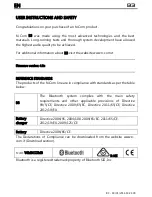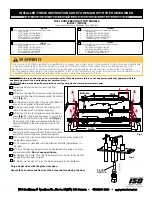
Page 14
Studio Reference
IIIII
&
II
II
II
II
II
Professional Studio Amplifiers
3.3.4 Input Connection
The balanced inputs have a nominal impedance of
10 K ohms (5 K ohms unbalanced) and will accept the
line-level output of most devices. Phone jacks are pro-
vided on the back panel, while the factory-installed
P.I.P.-FX provides female XLR input connectors (see
Figure 2.2). Optional
P.I.P. modules like the P.I.P.-BB
and the P.I.P.-FPX can provide barrier block and
phono (RCA) connectors. Various
P.I.P.s are also avail-
able which provide a wide range of input signal pro-
cessing features (see Section 8).
Correct input wiring depends on two factors:
(1) whether the input signal is balanced or unbal-
anced, and (2) whether the signal floats or has a
ground reference. Figures 3.8 and 3.9 show the recom-
mended connection techniques for each combination
of source signal characteristics.
3
1
2
+
–
INPUT
2-wire line cord
(or battery power)
Note: If two or more channels with
the same input ground reference
are driven from the same
floating source, connect
only one shield to the
source chassis.
Floating
source
3-wire grounded line cord
(or other ground connection)
Shield not connected
at this end
Grounded
source
3
1
2
Output
+
–
+
–
Output
+
–
INPUT
Fig. 3.9 Balanced Input Wiring
The amplifier’s built-in
1
¦
4
-inch input phone jacks can
be wired similarly for balanced or unbalanced, floating
or ground-referenced sources. They have a standard
tip-ring-sleeve (TRS) configuration: the tip is positive
(+), the ring is negative (–) and the sleeve is ground
(see Figure 3.10). Wiring for various sources follows
the XLR wiring examples in Figures 3.8 and 3.9.
If you install a
P.I.P. module other than the P.I.P.-FX,
P.I.P.-BB, P.I.P.-FMX or P.I.P.-FPX, do not connect in-
put signals to the phone jacks. The phone jacks are in
parallel with the output of the
P.I.P. module, so the
source connected to the phone jacks can feed into the
P.I.P. and generate a distortion in the output. The
phone jacks can still be used as “daisy chain” outputs
to feed the post-processed signal from the
P.I.P. to the
input of other amplifiers.
If the amplifier will be used in Bridge-Mono or Parallel-
Mono mode, be sure to follow the instructions provided
in Sections 3.3.2 and 3.3.3. Do not use the channel 2
input in either mono mode.
+
–
SHIELD
BALANCED
+
SHIELD
UNBALANCED
Fig. 3.10 Balanced and Unbalanced Phone Plugs
Fig. 3.8 Unbalanced Input Wiring
Twin-lead shielded cable
2-wire line cord
(or battery power)
Shield connected
to ground terminal
3-wire grounded line cord
(or other ground connection)
Shield is not
connected
at this end
Grounded
source
3-wire grounded line cord
(or other ground connection)
Input ground
terminal not used
Grounded
source
Single-conductor coax
or twisted pair
2-wire line cord
(or battery power)
Floating
source
Shield connected to both
negative (–) and ground
input terminals
+
–
INPUT
Output
Floating
source
+
3
1
2
+
–
INPUT
+
Output
3
1
2
+
–
INPUT
Output
+
3
1
2
+
–
+
Output
INPUT
3
1
2















































